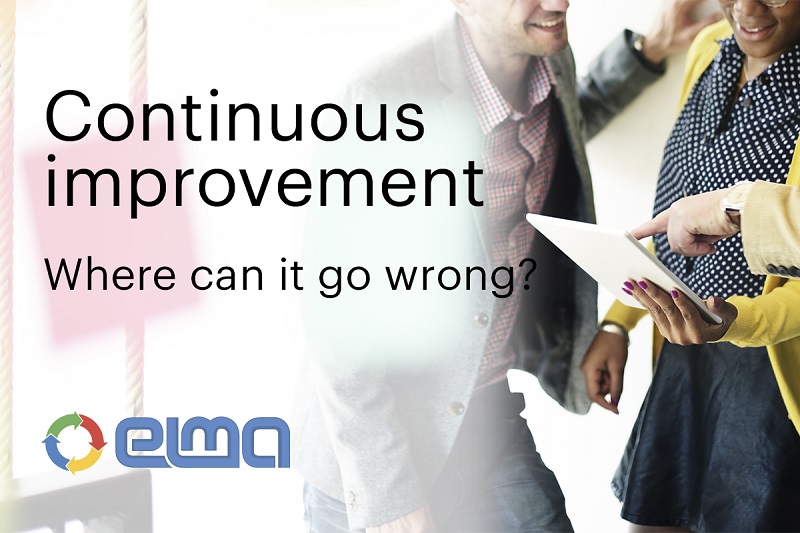Continuous improvement. Where can it go wrong?
Blog: Elma Blog
Continuous improvement is a process where businesses improve their overall function, products, and services. The improvement is ongoing and does not stop when a CI project is completed. It implies a specific approach and activities that involve the whole company and its processes.
Another term that is widely used is Kaizen, which is Japanese for “change for the better”. It was introduced by Masaaki Imai in 1986 in his book Kaizen: The Key to Japan’s Competitive Success.

Here are some key features of Kaizen:
- Improvement is based on many small changes rather than the radical changes
- Small improvements are less likely to require major capital investment than major process changes
- Ideas come from the employees themselves
- All employees should continually be seeking ways to improve their own performance
- It helps encourage workers to take ownership for their work and can help reinforce teamwork.
Many CI projects implement these tactics. So why doesn’t it always work out as expected?
Continuous improvement is supposed to correct the processes of a company and create an error-proof environment. However, humans are prone to errors, no matter how many software programs they have on their computers.
Here is what sometimes happens: people start relying too much on a process. After all, when it is all worked out and set up by professionals, nothing can go wrong, right? Isn’t that the whole point?
With this sort of thinking, you can come up to a stage when any mistake (for example, someone filling out the papers wrong) is blamed on the process, whereas in fact, the employees are neglecting their duties. Don’t get me wrong, automation is great. I love automation and all that comes with it. However, there must always be space for critical thinking. Otherwise, your improvement project will just not work.
Another important point here is CULTURE. I put it in capital letters only because it is something that you should never underestimate. Continuous improvement implies that all the employees are accountable, and both management and plant-floor workers work together. If your company lacks this philosophy, your CI project will not succeed even if you do everything else right.
You see, kaizen is not only about correct processes. The us and them categorization is inappropriate here.
Only when united by the company culture the employees will work together on achieving the company’s goals. How do you get to this point? To cultivate the continuous improvement culture, you have to make sure that every employee knows that even the smallest change makes a difference. If they see the slightest possibility of change, they should not hesitate to point it out.
Employees must know that their contributions are appreciated and valued, and then they will never lose the passion for improvement.
Here is something else you should be aware of: managers run the risk of not participating enough.
Sometimes, when they see that things are going fine and the CI project is almost completed, they turn their attention to something else, falsely believing that now the improvement is unstoppable. Wrong. Without the participation of senior managers, the project is bound to fail.
I do not mean to say that managers must always be there, pressuring the workers to implement solutions or deliver results. Going to extremes never works. However, statistics show that 33% of projects fail because senior management doesn’t get involved (Source: University of Ottawa).
So that is something to consider.

Now, the processes. I have said that you should not overestimate their value against human behavior. Even good processes can be harmful if treated as supreme intelligence. However, a bad process is just as wrecking. There are different approaches that you can choose to work on your processes. It is not a surprise that being a BPM evangelist at ELMA, I would recommend a BPM suite.
The BPM lifecycle includes improvement and enables it by making the processes more explicit and by providing real-time analytics. In fact, good software can help you to both automate the processes and make sure that the kaizen principles are implemented well.
Let’s say you have described, modeled and implemented a loan approval process. Everything works just fine, but after a while, one of the employees notices that you can save time on paperwork if you use a certain template. Faster process means better customer experience and isn’t that what every business wants?
In our company, for such cases, we use a special feature of ELMA BPM. While working in the system, employees can submit their suggestions on improvement. They can do it while performing a process task by just clicking a button. If they come up with an improvement idea at any other moment, they can send in their suggestion by running an improvement process in ELMA BPM. In either case, the suggestion automatically goes to the person in charge.
As far as supervision goes, ELMA BPM has all the means for monitoring and control. There are tools for performance measurement and evaluation, and features that allow you to engage everyone in achieving the company’s goals.
This is an example of how we handle improvement in our company. It has proven to be successful, but you can work out your own methods. If you would like to know more about our CI model, feel free to ask below.
Continuous improvement is people-oriented and is rather easy to implement as long as you do not focus on short-term success and can assure a long-term discipline. I strongly recommend reading Kaizen: The Key To Japan’s Competitive Success even if you have already completed a CI project. It can inspire you to look for new methods and tools. Keep an open mind, do not overestimate the power of automation, and try considering software that can do a great job for you, like a BPM suite.
Leave a Comment
You must be logged in to post a comment.








